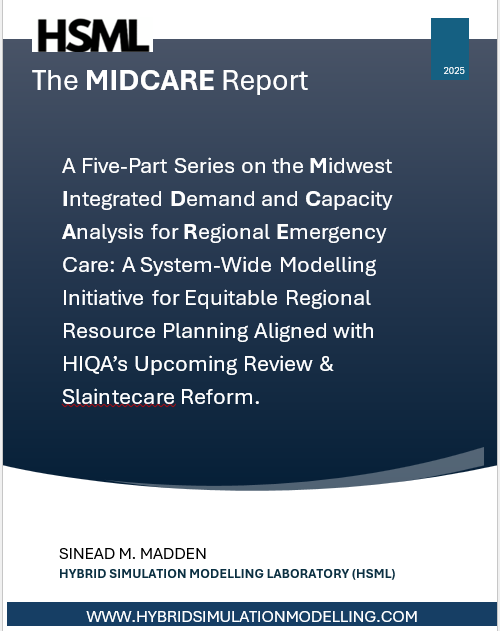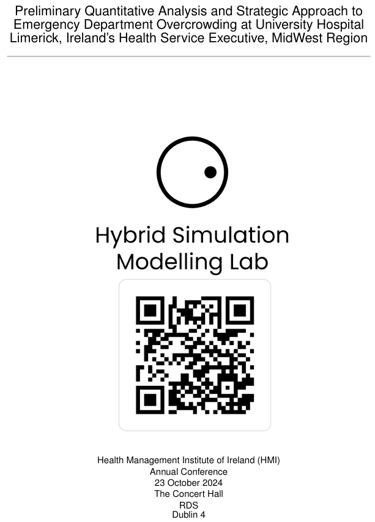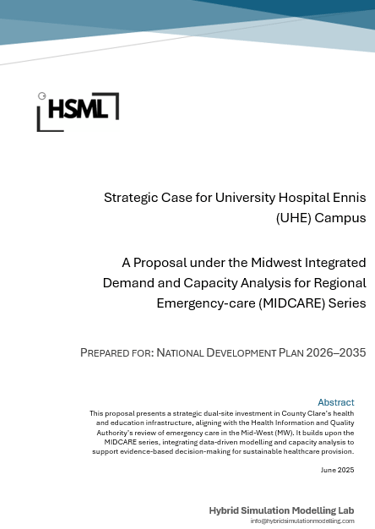MIDCARE Report Formally provided to the Department of Health and the Minister for Health
MIDACRE Brief formally sent to HIQA and Chair of Health Committee
Executive Summary
MIDCARE comprises five interlinked studies presented in four articles addressing structural inequities in emergency and acute care provision, providing timely, evidence-based insights serving as a valuable complement to the Health Information and Quality Authorities (HIQA’s) current review.
MIDCARE was developed in response to the May 2024 request by the former Minister for Health for an independent review under Section 8(1)(e) of the Health Act 2007, tasking HIQA with evaluating urgent and emergency care (EC) services in Ireland’s Mid-West (MW). While HIQA’s remit focuses primarily on operational safety, service configuration, and regulatory compliance, the Hybrid Simulation Modelling Lab (HSML) initiated MIDCARE to address broader structural and equitable issues not covered in the formal review.
The HSML led MIDCARE series fills critical evidence gaps by examining long-term acute bed and consultant workforce deficits, regional inequities in EC access, and system-wide bottlenecks through a suite of forecasting, geospatial, and simulation models. It also incorporates public trust and utilisation data, offering a population-based (strategic) and EC (operational) perspective essential to realising the equitable and decentralisation goals of Sláintecare. This work enables policymakers to engage with timely, regionally grounded, and future-facing decision-support tools that extend beyond HIQA’s narrower review.
May 2025


Key Findings from a Five-Part Series on the Midwest Integrated Demand and Capacity Analysis for Regional Emergency Care (MIDCARE): A System-Wide Modelling Initiative for Equitable Regional Resource Planning Aligned with HIQA’s Upcoming Review & Slaintecare Reform.
MIDCARE
Executive Summary
University Hospital Limerick (UHL), the only Model 4 hospital in Ireland’s MidWest region, faces persistent challenges with overcrowding and prolonged emergency department (ED) wait times. In 2023, UHL saw 80,113 ED attendances, averaging 219 daily presentations. By October 2024, this number exceeded 300 daily, straining the hospital’s 535-bed capacity. A spatial and capacity analysis projects a shortfall of 327 beds by 2031, including 128 unplanned acute beds and 199 outdated. Nightingale ward beds requiring replacement. The spatial analysis identifies Ennis, County Clare, as the most suitable location for a new Model 4 hospital. Redistributing 37,252 ED patients annually from UHL to regional hospitals such as Ennis and Nenagh (with 50 and 52 beds, respectively) is recommended as a short-term measure. In the long term, constructing a 353-bed hospital in Ennis would align with the Sláintecare framework’s goal of decentralising healthcare services, ensuring 1sustainable and equitable access for the MidWest region.
23 October 2024
Preliminary Quantitative Analysis and Strategic Approach to Emergency Department Overcrowding at University Hospital Limerick, Ireland’s Health Service Executive, Mid-West Region
Presented to Mr. Bernard Gloster, CEO HSE Ireland at the Health Management Institute of Ireland (HMI) Annual Conference 23 October 2024
Presented at public event in Ennis November 2024, provided to all County Clare public representatives and forms the basis of a HIQA submission


Preliminary Quantitative Analysis of ED Overcrowding at UHL
Proposal University Hospital Ennis
Strategic Case for University Hospital Ennis (UHE) Campus
A Proposal under the Midwest Integrated Demand and Capacity Analysis for Regional Emergency-care (MIDCARE) Series
Prepared for the National Development Plan 2026–2035
Provided to all County Clare Public Representatives
Executive Summary
This proposal, based on the Midwest Integrated Demand and Capacity Analysis for Regional Emergency-care (MIDCARE) series, forms part of a submission to the National Development Plan 2026 to 2035. It outlines a strategic dual-site investment in County Clare’s health and education infrastructure and aligns with the Health Information and Quality Authority's review of emergency care in the Mid-Wes (MW).
June 2025


Socials
Subscribe to our Newsletter
Location
Ennis
County Clare
Ireland
© Copyright 2025 HSML. All rights reserved
Disclaimer: Every effort has been made to ensure the accuracy of the information presented. However, the Hybrid Simulation Modelling Lab (HSML) accepts no responsibility for any loss, damage, or inconvenience arising from errors or omissions. Information is updated regularly, but HSML cannot guarantee its accuracy at any specific point in time. Users seeking to rely on this information should obtain independent confirmation directly from HSML. The outputs presented are developed independently by HSML to advance evidence-based decision-making, with a focus on measurable impact. The contents of MIDCARE (v0.1) are currently under peer review. Findings and interpretations are provisional, subject to revision, and may differ from final published outcomes. No part of this content may be reproduced without prior written consent. Full details of studies and associated simulation data are available upon request.
